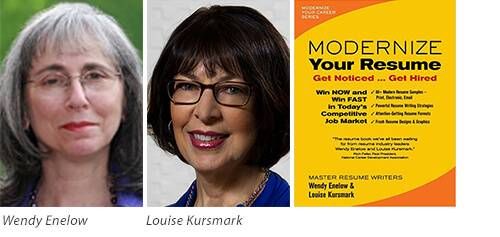8 Critical Ways to Improve Your Resume
The 'Modernize Your Resume' authors on what employers want
Writing a powerful resumé has never been easy. But in today’s online, mobile and tech-driven employment landscape, it’s especially challenging. That’s why it’s critical to learn how to optimize your resumé for electronic scanning systems and human readers if you want to get hired in 2016.
Fortunately, a new book I just read — Modernize Your Resumé: Get Noticed…Get Hired — by master resumé writers Wendy Enelow and Louise Kursmark, helps take the mystery out of the process. It features strategies to update your resume’s content, format and design and includes more than 80 samples from some of the world's leading resumé writers.
Here are eight tips, paraphrased from the book, to make sure your resumé stands out in 2016:
1. Write to the future, not the past. A resumé is a marketing document, not a historical record. Your current career goals should always determine which parts of your story to highlight and which to minimize.
The key is to give heavier emphasis to the credentials, experiences and accomplishments that relate to your objective and less to things that don’t. Older job seekers can briefly summarize their earliest work experiences without dates (if you choose this approach, omit your college graduation date). If you hope to make a career shift back to something you did years ago, note that prior experience prominently in a “Related Experience” section that comes before other Professional Experience.
Bottom line: Put the focus where it belongs.
2. Integrate critical keywords. Nearly every company and recruiter uses keywords to identify qualified candidates. If you don’t use the right ones, your resumé will be overlooked by the electronic applicant tracking systems — even if you’re the ideal candidate.
And using the wrong keywords can date you (for instance, “personnel” is old school; the right phrase is “talent acquisition”). So swap out your old lingo for the current language of your profession.
To help identify your most critical and up-to-date keywords, consult online job postings, the jobs and “About Us” areas of company websites, LinkedIn Group conversations and social media sources.
3. Showcase your “wow.” What are the top things you want employers to know to prove you’re an impressive candidate? Enelow and Kursmark call this your “wow factor” — a quick hit of information that highlights your achievements and that shows up prominently throughout your resumé.
To make your “wow” pop off the page, the authors say, position one “big wow” at the top, either above or below the headline that boldly states who you are (“Award-Winning International Sales Manager” or “Trilingual Digital Marketing Executive”).

Also, lead with a powerful “wow statement” when explaining your past jobs. For example, “Increased web traffic by 350 percent and doubled ad revenue over prior year.” Then, provide a brief write-up of your other responsibilities.
You should also list “wow content” under a separate category, such as an “Honors and Awards” or “Media Mentions” subhead.
To help hone in on your “wow” factor, ask yourself the following questions and then make sure the answers appear in your resumé:
- When have I been first or best?
- What is the No. 1 thing I achieved in each position?
- Which of my achievements have the most impressive numbers?
- What have I been publicly recognized for?
4. Ditch the Objective (and replace it with a Summary). “When you include an Objective, you’re telling employers what you want from them and, frankly, they don’t care,” write Enelow and Kursmark. That’s why the Summary section — a short professional synopsis that highlights your years of experience, job history and major achievements — has largely replaced the Objective in modern resumés.
The one time when an Objective might still be in order, they say, is when your Objective might not be clear from your work experience. In that case, use a clean and clear Objective to clarify things (for example, Objective: Early Childhood Program Coordinator).
5. Write “lean and mean.” Every word must count in a modern resumé. Here are a few tricks to, as the authors say, “leave the muscle, lose the fat:”
Quantify your achievements. Numbers provide a measurable indicator of your performance, so when possible, use figures, dollars and percentages to add credibility to your resumé. Just don’t overdo it: mix numbers and narrative to create a compelling read.
Add context to help employers better understand the magnitude of your accomplishments. So instead of “Increased revenue by 56 percent,” say: “Increased revenue by 56 percent, triple the company average.”
Start every paragraph or bullet point with a strong action verb. Not sure which words pack the greatest punch? Here’s a list of 429 action verbs to choose from.
Eliminate filler words and phrases. Terms like “responsible for” or “duties include” don’t say anything and dilute the power of your resumé. Others, like “references upon request,” state the obvious. When possible, ditch little words like “a” “an” and ”the” to make sentences tighter and shorter.
6. Make your contact information pop so busy hiring managers can reach you easily. Include live links to your email address, professional blog and/or relevant social media accounts. Include just one phone number (preferably a cell phone) and one email address. Eliminate your full mailing address — just your city, state, and ZIP code will suffice.
7. Improve your resumé’s skimmability. We all skim more than we read, so to reward that reading style: Write short paragraphs of three or four lines at most. (If you have more to say, create a paragraph plus a bullet list.) Also, add white space between paragraphs to provide “breathing room” and use headings and subheads to segment and introduce information.
8. Punch up the design (cautiously). Color, shading, boxes, charts, tables, images and icons can be valuable additions to your resumé, helping to make it stand out. Just make sure your design matches industry norms for your field — a graphic designer can comfortably display more creativity than an accountant. To see samples of creative resume designs, click here.


